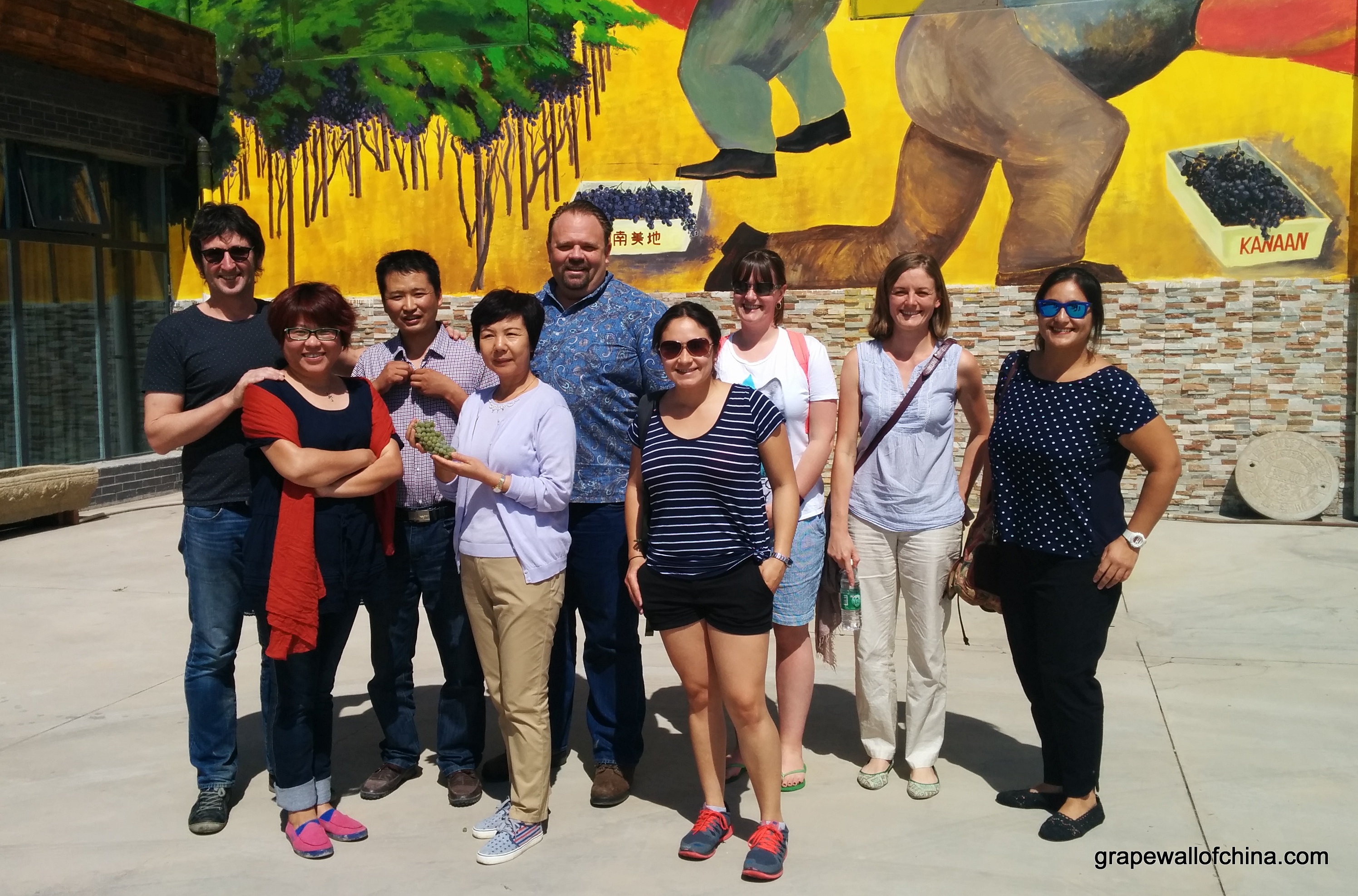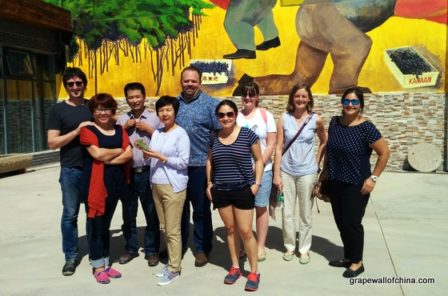
By Jim Boyce | Brian Cheeseborough was one of 48 winemakers from 18 nations who traveled to Yinchan last fall to join a two-year project called Ningxia Winemakers Challenge and has since spent more time in this wine region than any other participant. I asked him a few questions about his initial experiences and then about what’s he learned over the past year.

What was your travel route to Ningxia?
It was a nearly 27-hour journey, including layovers and connecting flights, from San Luis Obispo (California) to San Francisco through Shanghai and arriving in Yinchuan just after midnight. I arrived early for the annual wine exposition and then spent nearly two weeks touring across Ningxia with six other winemakers from the Challenge. We dubbed ourselves “the Originals†in our WeChat group.
NWC winery partners range from big producers to boutique operations, with accommodations spread from capital Yinchuan to over 100 km away and equipment varying from place to place. What winery did you get as a partner?
My lottery number matched me with Yutian, which is still under development, but arrangements had been made for my lot to be made nearby at Chateau Lanyi, just a few kilometers north of Zhenbeibu and the film studios northwest of Yinchuan.
Lanyi is a boutique winery with an interesting cellar configuration of four levels and six working areas. The pumps and cellar equipment are simple; most of the tanks have heating and cooling with a few just for short-term storage and blending. Barrel storage is subterranean with a capacity of about 200 if they are stacked two high. There is no forklift and everything, from pomace to barrels, is carried up and down the stairs.
Each winemaker had three hectares of grapes last fall to make a red wine. How was your fruit quality?
My lottery block was #60 and the vines were planted in 1997. There was probably a little more canopy than I would prefer. With the heat, I exercised patience and waited. Then we had a big storm. Rather than rush through to harvest, I elected to wait out the rains and ended up picking nearly two weeks later, on October 8, with good maturity and no discernible damage from the weather. Lucky 8? Perhaps.
Some fruit was removed from the sorting tables, but less than 2 percent in all. I had three tanks with just over 14 tons ready for a saignee and then a good cold soak. I was quite happy with the chemistry and I didn’t need much in the way of acidulation, with a happy pH of just under 3.7 and potential alcohol over 14 percent. Aside from a hydrometer to measure density and a questionable pH probe, I didn’t have any other lab equipment to work with. It was pretty much back of the hand and daily monitoring during the fermentation.
I was fortunate that I was provided enough barrels for all of my production, though more than half are three to four years old. How much of a factor on the style? In a dream, I would have wished for a row of new barrels laid down for malolactic fermentation, but instead, the wine spent the first six months finishing malolactic in stainless steel and then was racked clean to barrel in May. There is a fruit-forward presence, but I am optimistic about the balance brought about by a few bags of oak during malo and a couple of new 500-liter puncheons. Still debating when to bottle though and much undecided.
You were in Ningxia a few weeks ago when the region unexpectedly got about a year’s worth of rain. What was the impact?
I spent most of my summer in the area near Zhenbeibu, so I can’t speak directly to the conditions further south, but the heavy rains were mostly isolated to the mountains and resulted in flash flooding. About 350 hectares were severely affected by the floods, but those who were not still had to deal with the relatively high humidity that hung across the vineyards for most of August. Even with an aggressive sulfur regime, there is some rot. Sorting tables will be a valuable asset for the 2016 harvest. I wouldn’t be surprised if there are some isolated cases of botrytis either.
You recently took part in a tasting of over 100 Ningxia wines and said you saw regional differences.
In two days, we tasted, evaluated and briefly described 103 wines. The tasting was organized by Ningxia University with aims of publishing a wine guide for all of the region. The early stages of tourism development?
I was one of five reviewing judges, including Dave Tyney, Dr. Ang, Dr. Lee and Dr. Jin. Interestingly, all three of the latter judges earned their doctorate degrees from either Adelaide or UC Davis.
There are easily five different terroirs in Ningxia and arguably seven or even eight. It is something we noticed on the second day of tasting and led to an unexpected appreciation of Ningxia as a developing wine region.
The identified regions are Helan, Yinchuan, Yongning, Qingtongxia and Hongsibu. There are also discernible differences in the Yinchuan region; the proximity to the tombs resulted in an obvious variance versus the region south of the city. The other “undefined†sub-appellation is in the Helan region in Jin Shan north of Zhenbeibu, right against the foothills. There are many new vineyards being developed in this region, with over half not even producing wine yet. Hedong winery, in the far northern reaches of Ningxia, could also be considered an appellation of its own, although we didn’t have any other wines available to taste and compare from that area.
We didn’t have all of the information about each vineyard, so the observations could use further refinement, in terms of vineyard documentation, yields, and sensory analysis. Many wines were non-vintage, so judging between vintages was difficult, as was determining value. We didn’t have retail prices for most wines, which would also be an interesting marketing study all in itself. I suspect the range is pretty wide, although quality is a much narrower spectrum.
Overall, the quality was very good, typified by clean wines without any major enological defects. There were about a dozen exceptional wines. The red wines dominated the two-day flight, by almost a four-to-one ratio, with a few roses and three dessert wines. (I only wish I had photocopied my notes. They were submitted for the publication.)
We only observed a few wines resulting from poor winemaking and three from TCA (bad corks), and did not judge the latter. The most common default we observed was premature oxidation.
You have made wine in Argentina, France, and the United States. What differentiates your experience in Ningxia versus those other countries?
The most notable difference I have witnessed is the willingness of nearly everyone involved wanting to learn more. Just about everyone is a first-generation winemaker or viticulturist; they don’t have decades or generations of previous vintages to lean upon.
Do we make an ‘old world’ wine or a ‘new world’ style? The wine culture is still very young. Everyone seems eager to compare their wines to those of Bordeaux or Napa Valley. I’ve made wine in both places and Ningxia is neither.
The wineries of Ningxia are, however, crafting distinctive wines that represent this terroir and that can be considered equal to those of great heritage now and, I believe, even more so by the end of this decade. It won’t be just an anomaly, but a regular occurrence, and from numerous wineries. After the 100-plus wine I tasted last week, I believe this to be very true, not based on just a few wines, but the region as a whole.
If you could pick one grape that Ningxia should be famous for in ten or twenty years, which would it be?
A question for the crystal ball. Cabernet Sauvignon obviously has a firm foothold. There is also some interesting Cabernet Gernischt, but it works better as a blending component in my opinion. The same can be said for Cabernet Franc, but there is far less of this classic Bordeaux variety. To a lesser extent, Merlot can stand alone, but from my personal experience in working with some barrels here, it needs a little assistance from the three aforementioned grapes.
If I were to stop here, my recommendation to the winemakers of Ningxia would be to embrace all four and make the best wine possible, regardless of varietal labeling. Very Bordelaise of me, perhaps, but my vintages in St. Emilion had some influence on my blending directions. Additionally, don’t be afraid to make second or multiple-tiered wine programs, blending for quality over quantity.
As for my choice, the Marselan shows great potential. Viticulturally, it can yield a good-sized crop and ripens a little earlier in the Ningxia harvest season, avoiding the late October threat of frost that could end the harvest overnight if the grapes are still hanging. As a wine, it has the best of both Cabernet Sauvignon and Grenache. It’s fruit forward with good structure, has silky tannins that are less than chewy, and hints of red fruit flavors even when it is fully ripe for added complexity. I had the opportunity to work with this grape last year, but only had a few tons and we made a dessert-style late harvest wine. This year, I hope to make a dry lot and explore the other side of this variety.
You can check out other Meet the NWC Winemakers posts here.

Sign up below for my China wine e-newsletter. Check out sibling sites World Baijiu Day and Beijing Boyce. And see here for ways to support Grape Wall.
Grape Wall has no sponsors of advertisers: if you find the content and projects like World Marselan Day worthwhile, please help cover the costs via PayPal, WeChat or Alipay.
Sign up for the free Grape Wall newsletter here. Follow Grape Wall on LinkedIn, Instagram, Facebook and Twitter. And contact Grape Wall via grapewallofchina (at) gmail.com.

Leave a Reply
You must be logged in to post a comment.